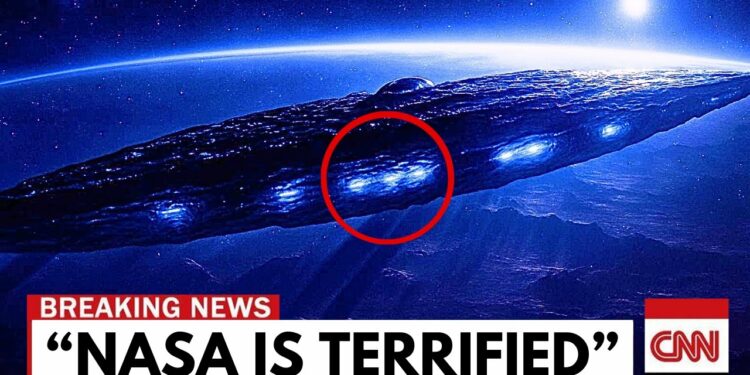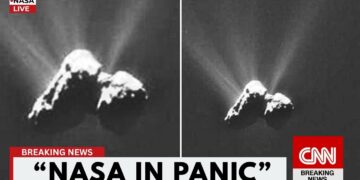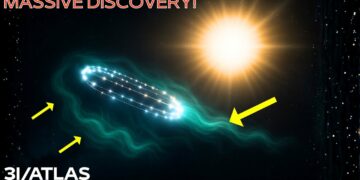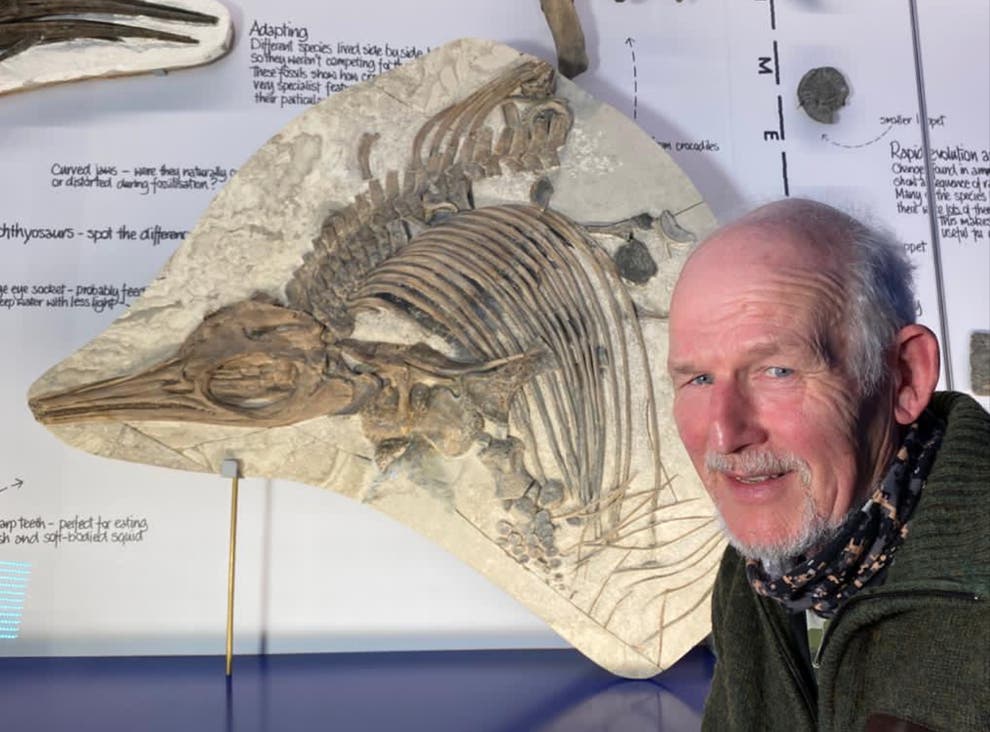In the silent reaches of the cosmos, something has begun to glow. Not the radiant burn of a star, nor the reflected shimmer of sunlight on ice, but a light that pulses with intention. Astronomers first noticed it while observing 3I/ATLAS, an interstellar visitor hurtling through our solar system. It was supposed to be just another comet, just another rock drifting between stars. But what the James Webb Space Telescope recently detected suggests otherwise: a new kind of light—one that doesn’t reflect, doesn’t scatter, but shines as if created, as if engineered.
At first, it was dismissed as just another overblown anomaly—maybe a camera glitch, maybe dust. But the light persisted. And then it grew. Now, scientists don’t know what to say, because the patterns of brightness don’t follow the rules of nature. And when artificial light is the only explanation left standing, the implications are terrifying. So, what exactly did the James Webb uncover? And why is the scientific community in a quiet state of panic? Stay with me, because what you’re about to hear may change everything we thought we knew about who—or what—is watching us from the darkness.
From the moment 3I/ATLAS was spotted, astronomers sensed something was off. Yes, it moved like a comet. Yes, it appeared to follow a classic interstellar trajectory. But its brightness—its unbelievable brightness—refused to be explained. At a distance of over 400 million km from Earth, this object shone with a magnitude of 16.4—not a blazing inferno by astronomical standards, but still too bright for something that size. Comets of similar size and distance are typically invisible or, at best, faint smudges. And yet, 3I/ATLAS glowed with a defiant, almost eerie intensity.
Astronomers scrambled for explanations. Maybe it was bigger than expected. Maybe it was kicking off vast clouds of dust that reflected light toward Earth. Maybe it was just an extreme case. But one by one, these theories began to collapse. The James Webb Space Telescope peered deeper into the spectrum, analyzing the light with precision instruments far more sensitive than any telescope in history. And what it saw wasn’t reflected light at all. It was emitted light—a source of luminosity radiating outward from the nucleus of 3I/ATLAS, as if the object itself were generating its own glow.
The idea that a comet could produce its own light contradicts the fundamental rules of how objects behave in space. Natural bodies do not generate significant visible light unless they are stars or heated to thousands of degrees. But the brightness profile of 3I/ATLAS refused to match any known comet model. In fact, the brightness fell off at a slope of -4, far steeper than anything caused by reflected sunlight. This steep decline suggests a central light source surrounded by a scattering halo, almost like a spotlight enveloped in mist.
But there was more. Spectrographic analysis revealed no trace of the usual comet gases—no carbon monoxide, no cyanogen, no water vapor—nothing that would account for volatile outgassing or dust jets. That left one radical possibility: the object wasn’t reflecting light. It was creating it. The energy required? Roughly 10 GW—that’s the output of 10 nuclear power plants combined, an absurd, almost unthinkable figure. Unless this object was something entirely different. Something engineered.
Some suggested it could be a nuclear fragment from a supernova core, still glowing with radioactive heat. But even this couldn’t match the observed intensity or spectral signature. So, the scientific community was forced to confront an explanation they weren’t ready for: artificial origin.
Enter Avi Loeb, the Harvard astrophysicist who famously suggested that ‘Oumuamua, the first known interstellar object, might be an alien probe. For that, he was ridiculed by many in the field. But he didn’t back down. And now, with 3I/ATLAS, Loeb is back—and he’s not alone. Teaming up with physicist Eric Keto, Loeb analyzed the object’s light curve and published a model that fits the observed data far better than conventional explanations. In their model, a central energy source—artificial in nature—illuminates the surrounding dust, creating a light profile unlike any natural body. They even calculated the required temperature of the emitter: at least 1,000° Kelvin. And at that temperature, a light source just 100 m wide could produce everything we’re seeing—a small, compact, powerfully radiant emitter, suspiciously similar in size to some human spacecraft.
So, what is this thing? A beacon? A power core? Or something we’ve never seen before? The implications of this model are staggering, because if 3I/ATLAS is not a natural object, then we are no longer alone in the cold void of interstellar space. We are being visited.
The strangeness doesn’t end with the light. 3I/ATLAS is not behaving like a mindless wanderer. Its path through the solar system is unnervingly precise. It’s moving along the plane of the ecliptic—the same plane on which Earth, Mars, Jupiter, and most planets orbit. And its trajectory is bringing it within striking distance of all three. Not randomly, not barely, but within a range so close that, hypothetically, even primitive interplanetary missiles could be launched from it to each of those planets. Even more chilling, during its closest approach, Earth will be on the opposite side of the sun, effectively blind to direct observation—almost like a cloaked passage designed to evade detection at the most critical moment. Coincidence? Or is this flyby hiding something more sinister?
Some theorists have begun to suggest that the surrounding dust cloud might not be natural either—that it could be a swarm of microscopic machines, nanotechnology gathering interstellar matter for fuel. We’ve seen similar mysteries before. Astronomers once observed a star lose its dust ring overnight, an event they still can’t explain. What if this is the same thing? What if 3I/ATLAS is harvesting?
Weeks after the initial anomaly was registered, the James Webb team expanded their monitoring into non-visible spectrums—infrared, microwave, and most curiously, the radio band. It was here that things took an even darker turn. Hidden behind the artificial glow, there was a signal—weak, nearly buried in cosmic noise, but consistent. It pulsed in a way that was rhythmic but not random—a sequence that repeated every 7.2 hours, not long enough to be a natural rotational delay, not short enough to be interference. But what stunned researchers the most was its frequency range: precisely within a narrow band that Earth-based military and communication satellites reserve for secure transmissions. The odds of that overlap being random are astronomical.
This raised an even more chilling theory: What if the light isn’t just a byproduct of propulsion or energy? What if it’s communication—a language of photons encoded in pulses and frequency shifts? And worse, what if it’s not a message to us, but a message through us, piggybacking on Earth’s own communication structure? Some believe this is a tactic used in espionage: embed your transmission inside another system, and no one notices until it’s too late. If that’s what 3I/ATLAS is doing, then the image we’ve been watching may actually be a code we’re blindly helping to transmit.
Around the same time, an independent research group led by astrophysicist Laura Jen from the University of Tokyo reported something equally alarming. While analyzing time-lapse frames from Webb’s ultra-deep field captures, her team noticed that 3I/ATLAS’s light intensity wasn’t just fluctuating. It was pulsing in binary: light, dark, light, dark—not flickering like a dying star or a spinning object, but in precise intervals, always consistent, always repeating. Over time, a pattern emerged: every 16 pulses, there would be a delay; then 32 pulses; then another delay. What they had was not noise. It was structure. It mirrored known binary codes used in digital language frameworks.
Computer scientists began experimenting, plugging the sequences into known data decoders, AI interpretation models, even running them through ancient language software. The result: a partial match. The sequence bore structural similarities to early Earth-based computing protocols from the 1970s. This shouldn’t be possible, but it sparked a terrifying idea—that the intelligence behind 3I/ATLAS might be tailoring its signals to match our primitive digital language, almost as if it has been watching us, learning from our broadcasts, preparing a message we’re capable of understanding.
This isn’t the first time light in the dark has triggered alarm. In 1979, the Vela satellites detected a mysterious double flash over the Indian Ocean. For decades, the event was buried under theories of secret nuclear tests, gamma-ray bursts, and meteor impacts. But now, revisiting the signal in the context of 3I/ATLAS, researchers noticed uncanny similarities: the pulse width, the decay pattern, the signal’s symmetry. Several data scientists cross-referencing the Vela readings with the Webb observations noticed overlap in modulation and strength curves. As insane as it sounds, this opened a terrifying hypothesis: What if 3I/ATLAS was here before? What if the 1979 double flash wasn’t a test at all, but a visit? Or worse, an activation—an early probe, a scout? And what if what we’re seeing now is simply the return of something we weren’t supposed to remember? After all, governments buried the Vela flash for over 30 years. What are they burying now?
Finally, Webb’s temperature sensors captured something unexpected: not just heat, but absence—a trail of ultra-cold vacuum following 3I/ATLAS, darker than space itself. This cold wake contradicts everything we know about thermodynamics. Even objects in space maintain residual warmth from solar radiation. But 3I/ATLAS is shedding something that consumes energy, draining the very fabric around it like a black veil dragging through space. Astrophysicists call this a negative energy field—a hypothetical concept used in warp drive theory and time dilation physics. The presence of such a field would suggest that 3I/ATLAS isn’t moving through space. It’s bending space around it. That would explain its impossible acceleration patterns, its lack of friction, its silent traversal. It would also explain why it can shine while remaining functionally cold. The light is not from heat. It’s from manipulated energy. And if it’s bending space to travel, then we have no idea where it came from or where it’s going. Or worse, if it’s already here.
James Webb’s latest series of long-range exposures revealed something even more confounding: thin filament-like structures trailing behind 3I/ATLAS, similar to the condensation trails of high-altitude aircraft. But in the vacuum of space, contrails can’t exist. There’s no atmosphere to create vapor, no temperature shift to freeze particulate matter. And yet there they were—trailing lines of high-energy particles, symmetrical and layered like a lattice. Scientists dubbed them “ghost trails.” These ghost trails were unlike any cosmic dust phenomenon previously recorded. They weren’t chaotic. They formed intersecting angles and overlapping arcs, almost like a navigation grid—as if the object were mapping space in real time.
Some physicists proposed that the trails were quantum echoes, residual distortions from manipulated gravity fields. Others theorized they were signs of an exotic propulsion system—possibly ionic, or even beyond that, something akin to field inversion. But perhaps the most radical idea was the most chilling: the trails were not leftovers. They were intentional—like breadcrumbs, a signal, or worse, a path for something else to follow.
Then came the moment that tipped everything into true paranoia: a gap, a missing window in the James Webb data logs. For 47 minutes, the telescope’s primary sensors ceased transmitting visual data from the 3I/ATLAS observation stream. No technical malfunction, no solar interference—just absence, a void. When the feed resumed, 3I/ATLAS had shifted trajectory slightly—only by 0.17°—but enough to raise every eyebrow at NASA and ESA. Analysts cross-referenced with backup systems, but the blackout was consistent across multiple instruments. This triggered whispers about the observer effect—a quantum theory stating that watching an event can change its outcome. Some even dared to say the object had responded to being watched, changed course, hidden—as if it knew we were looking.
A chilling theory emerged: What if 3I/ATLAS isn’t just passing through our system? What if it’s testing our surveillance capability?
Later, during what should have been a standard stellar occultation—when a celestial body passes in front of a star—astronomers noticed something disturbing. As 3I/ATLAS moved across the line of sight to a distant star, the star’s light didn’t dim smoothly. Instead, it flickered—not in a natural fade, but in structured on-off intervals. The brightness dipped in exact sequences: three pulses, pause, five pulses, pause, three again—3-5-3 over and over. Not only was this not random, but it also resembled a signaling pattern used in early radio Morse code. The implications were staggering. If the object could block starlight in a structured pattern, it meant it could manipulate its own silhouette—literally changing how it appeared depending on who or what was observing. This wasn’t just advanced technology. This was performative behavior, designed to be seen, measured, decoded. But for whom?
As the object moved past its perihelion—its closest approach to the sun—Webb detected an unsettling transformation. The glow that had once been warm and golden began to shift: cooler, bluer, sharper. It began to radiate not as a fuzzy cloud, but as a focused beam—not unlike a lighthouse slicing through mist. The energy profile inverted, producing more shortwave frequencies than ever before. The conclusion: the object was adjusting its emission spectrum. But why? One theory stands out. Earth’s atmosphere is most transparent to specific bands of electromagnetic radiation—optical, infrared, and certain microwave windows. It’s possible the object was tuning itself to become more visible—but not just to humans, to machines, to sensors, to surveillance systems. Or perhaps to respond to something we already sent into space. Voyager, Pioneer, New Horizons—all carry messages: golden discs, binary pulses, maps to Earth. What if 3I/ATLAS wasn’t randomly passing through? What if it was answering?
As the scientific community delved deeper into the light anomalies of 3I/ATLAS, something strange happened. Public access to the James Webb live feed data was restricted. Without prior announcement, entire archives of images taken during the object’s closest approach to Earth were quietly redacted. Observatories collaborating with Webb were issued NDAs, and several amateur astronomers reported being contacted by unnamed government representatives after posting high-resolution stills online. This sudden shift from open science to classified silence hinted at only one thing: military involvement.
Speculation exploded. Was the object considered a threat? Had defense satellites picked up something that the public wasn’t allowed to see? Or worse, had someone—or something—responded to the object? What had once been an astronomical curiosity was now under the scrutiny of top-level defense agencies across multiple countries. And when NORAD—which normally deals with Earthbound and near-orbit objects—included 3I/ATLAS in its tracking logs, it became clear this wasn’t just about science anymore. It was about security, about control, and possibly containment.
Behind the optical mysteries, behind the emissions and lights, a new anomaly emerged: gravitational. As 3I/ATLAS continued its trajectory through the solar system, sensitive instruments on both the James Webb telescope and Earth-based LIGO detectors began registering micro-disturbances in spacetime itself. It wasn’t just bending light. It was pressing against the very fabric of reality. The wake it left behind wasn’t a trail. It was a ripple—a localized wave in the gravitational field that behaved unnaturally. Instead of dispersing like a normal gravity wave, it persisted, lingering like a shadow even after the object had moved on. The only comparable event in modern science was the gravity anomaly observed near the black hole M87*, but even that paled in comparison to this.
Some theorists suggested that this could be evidence of a self-contained gravity well—a technology far beyond our understanding, possibly akin to a warp field. If true, it meant 3I/ATLAS was not moving through space in a traditional sense. It was displacing space itself. That kind of capability isn’t just advanced—it’s godlike.
In a last-ditch effort to contextualize what humanity was seeing, a group of SETI researchers ran the artificial light sequence through the Drake Archive—a vast repository of all known attempts to detect alien life, including recordings of signals intercepted by deep-space antennas. After filtering noise and running AI-enhanced comparisons, a match was found—not perfect, but close enough to raise alarms. The pattern seen in 3I/ATLAS bore striking resemblance to a brief, one-time burst detected in 1998 by the Arecibo Observatory—a signal dismissed at the time due to its short duration and irregular frequency. Reanalyzing it now through the lens of the 3I/ATLAS pulse structure, the match became eerie: the same sequence of modulated intensity, the same time-spaced pauses, even the same mirrored structure.
If both signals originated from the same source—or same species—then this wasn’t their first visit. It was a return. And perhaps that original signal in 1998 wasn’t random. Perhaps it was a test ping, a call. And now 3I/ATLAS is the response.
And just when it seemed things couldn’t get stranger, the James Webb team made a final observation: 3I/ATLAS appeared to be reflecting something back toward Earth. At first, it seemed like a simple albedo reading—light bouncing off the surface. But a closer analysis revealed the reflected signal had been altered, contorted—as if passed through a lens or something more complex, a filter. What Earth had transmitted into space through radio, television, and radar waves was being mirrored back. But it wasn’t the same. The returning signal was filtered through patterns of symmetry, interference, and modulation. In essence, it was like a deliberate remix of Earth’s own broadcast history: news reports, music, digital pulses—echoes of ourselves, but twisted. Like someone—or something—was responding not just with light, but with our own voice played back in an unfamiliar tone.
It begged a final, chilling question: What if the signal is a mirror? A test—not just to see who we are, but how we react to ourselves.
In the vast silence of the cosmos, light has always been our only whisper—a faint trace left by stars, planets, comets, and now something else. Something that doesn’t behave like any natural object we’ve ever seen. 3I/ATLAS wasn’t just glowing. It was speaking. Its light wasn’t chaotic or random. It was structured, intentional, alive. And maybe that’s the most unsettling truth of all: that in our pursuit of knowledge, we’ve stumbled upon something that was waiting to be seen—something ancient or advanced enough to understand how to communicate not with sound, but with light frequencies, gravitational waves, and encoded reflection.
Perhaps the true purpose of 3I/ATLAS wasn’t to pass through our solar system unnoticed. Perhaps it wanted to be observed, wanted to test how far we’ve come—how curious, how capable, how blind we still are. And the James Webb telescope—the most advanced eye humanity has ever opened—may have done exactly what it wasn’t supposed to do: look directly into the signal. We didn’t just detect lights. We triggered a response.
Now, the question isn’t what 3I/ATLAS is. The real question is: what happens next? Because if something out there just acknowledged our presence, it may already be on its way.























